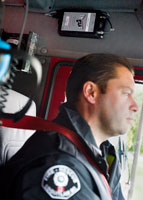(Original article by Angela MacKenzie appeared in Coquitlam NOW, Friday, October 10, 2008)

Firefighters in Coquitlam are using advanced technology to get to emergencies faster.
On Monday, Coquitlam council watched a live demonstration via web cam of the fire department’s new EMTRAC traffic signal system that gives fire and rescue vehicles priority at traffic intersections throughout the city.
A city van equipped with an EMTRAC device demonstrated how a vehicle would travel through a major intersection without having to slow down or stop.
Coquitlam Fire and Rescue trucks are being fitted with the EMTRAC traffic signal system to help with response time and intersection safety.
The EMTRAC device, about the size of a book, is mounted in the interior of the vehicle.
When activated by the release of the emergency brake and switching on of flashing lights, the device automatically sends a signal to the traffic lights when the vehicle enters a specific zone.
The area of that zone is tailored to the intersection by city traffic technologists, but can be up to approximately 900 meters (3,000 feet) away.
The traffic signal for the vehicle then changes or remains green.
At the same time, the other signals in the intersection change to red to stop all other cars, allowing the priority vehicle to pass through without slowing down or stopping.
The advance signal allows enough time for pedestrians to finish crossing and for other cars to stop safely.
“If we come up to an intersection that is totally clogged, it can add 30 seconds to a minute to our response time, which can make a difference,” said Coquitlam Fire and Rescue assistant chief Tom Boechler.
The system is expected to help improve response times by up to 20 per cent and increase safety at intersections.
All emergency vehicles find it difficult to move through heavy traffic, but Boechler says fire trucks are also typically larger in size than other emergency response vehicles and consequently not as maneuverable.
“Emergency driving is always a problem,” he says.
“With heavy traffic, it’s always a problem because you don’t know what the people in front of you are going to do. They’re supposed to pull over to the closest curb, but a lot of them just hit the brakes and stop.”
The city estimates it will cost $290,000 to equip all of the department’s fire and emergency vehicles.
Installation of the new system began in April of this year and approximately 75 percent of the vehicles have the devices installed.
Boechler believes it is money well spent.
“It may seem like a large amount of money at the beginning, but amortized over the lifetime of the system … It’s the life safety that’s the issue,” he says.
“One injury could make up for that cost.”
